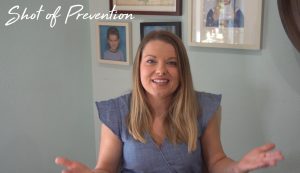Contagious–what if you got the measles?
You just stepped off a plane from a restful trip overseas–one you spent exploring new cities, cultures, and wildlife. Too bad, it’s time to head back to work and real life after this much-needed time away.
It’s been a little over a week, and you’ve developed a nasty cold with a high fever. Since you feel miserable, you decide to stay home.
Your friend calls and offers to bring you some chicken noodle soup, which you decide sounds nice. He comes, hands you the soup and some acetaminophen to bring down the fever, but it does no good. Your friend leaves, and you roll over to sleep off the fever.
Now you’ve come down with diarrhea, and as you pass the bathroom mirror, you notice your eyes–red and watery. Pink eye? How did that happen? This whole thing is getting grosser by the minute. You’re not sure about the whole pink eye thing, so you head to the walk-in clinic for some drops.
The doctor looks you over. It’s standard procedure to check your ears, nose, and throat with cold-like symptoms. She quickly backs away, looking concerned.
What’s going on?
She grabs a mask and washes her hands, then cracks the door and yells for another doctor to come in. They whisper, and he grabs a mask and gloves before asking to look in your throat.
So many questions. Have you been overseas? Where have you been? Who have you been around? Are you fully vaccinated?
You aren’t sure if you are fully vaccinated. Didn’t your parents take care of this over thirty-five years ago? You’ve never even given it a thought.
Why?
They tell you not to panic, but they believe you may have caught the measles. You can’t leave the room.
You learn your throat is covered in distinctive spots called Koplik spots, and the red eyes, fever, and cold-like symptoms are symptoms of the measles.
The measles! People don’t catch the measles any longer!
It’s too late to take preventative measures. They are worried about all the other people you’ve encountered, encluding those who rode the plane with you. Have you been around friends, family, and co-workers? They all need to be quarantined if they aren’t immune. Even being in the same room with someone means they’ve been exposed and possibly have contracted the highly-contagious disease.
This is not good. You have exposed so many people. Your friend bought you soup today.
All of these people need to be examined and must not leave their homes. You learn that unvaccinated people may need to stay home for 21 days. That’s 21 days of missed work and fear of what may happen if they should develop the measles. They could be hospitalized or worse.
Public health authorities will soon be involved. A public announcement will be given, stating that people who were on the plane and who may have encountered you at the airport have been exposed. The unvaccinated must be on high-alert and should remain at home.
Thankfully you live alone. No one may enter your home, not even to give you groceries. All essentials may be placed at your doorstep.
Not even a day later, you develop the rash. It starts on your face and travels down your neck, trunk, arms, and finally to your legs and feet.
The bumps are raised and small, but sit atop red spots. Soon the spots join together and form mats from your head to your toes. You’re burning up. Your fever is over 103 degrees, and nothing helps to bring it down.
The spots start to recede gradually. You’re lucky because you’ve suffered no severe complications.
Your quarantine has given you too much time to search the internet for what could have happened. You could have been severely impacted by this or worse.
For nearly a year following this infection, you are plagued with constant colds, sore throats, and ear infections due to your weakened immune system.
You did your best not to pick at the bumps, but you are constantly reminded of the measles every time you see the scars left behind on your skin. You wonder if they will ever fade away or if you will have to live with them forever.
This also reminds you of the four people who contracted measles on that plane that day. One was a small, unvaccinated child who spent weeks on life-support. Maybe it wasn’t your fault, but you can’t help thinking that you may have started it all. You will have to live with that thought for the rest of your life. Lives were forever changed.
Now that you know how terrible the measles is, even without complications, you’ve become an advocate of the measles vaccine. You’ve learned, like smallpox, the measles could potentially be eradicated. No one deserves to be plagued with this. No one deserves to lose a family member, a friend, a child to this unbelievably contagious disease.
Here’s what you want people to know:
- Getting your child vaccinated is the only way to protect them from measles, as two doses of the vaccine are 97% effective in preventing measles infection.
- You can find out if you have been vaccinated by locating your immunization records. You can find suggestions on how to do this on the CDC website HERE: https://www.cdc.gov/vaccines/adults/vaccination-records.html
- You can have your physician test you to see if you have immunity (to just about any disease).
- If you were born before 1957 and haven’t had the measles as a child, you may need to be vaccinated. Consult your doctor.
The measles is serious. Don’t take this lightly. You are doing your child a disservice by not getting him or her vaccinated. You have the moral responsibility to do what’s right for your community. Don’t be a part of the problem.
Photo credit: William Brown/Op-Art


